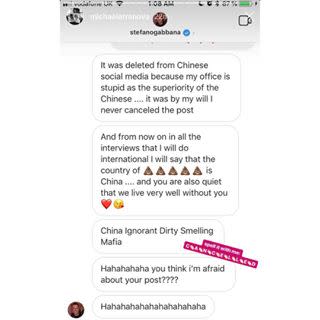What to Watch: The Power of the Screenshot

First, we had the e-mail leaks. Now, it’s all about the DMs.
In 2018, it seemed like global fashion and beauty businesses were merely a screenshot away from a major scandal.
In November, screen captures of racist comments by Stefano Gabbana’s verified account in a conversation conducted via Instagram direct messages were posted on “call-out” Instagram account Diet Prada. The uproar naturally resulted in a backlash and lead to the cancellation of the brand’s Shanghai show.
Weeks later, screenshots of personal conversations between Russian designer Gosha Rubchinskiy and 16-year-old Jan Silfverling, again posted on Diet Prada, seemed to suggest Rubschinskiy was trying to coax racy pictures from the youth.
Forget anonymous sources — does the future of fashion reporting lie in social media and its very own form of evidence, the dreaded screenshot?
By definition, emotion-driven, social media usage is seen as character-revealing. Slip-ups can’t be denied: The screenshot has become the ultimate — and unquestionable — evidence of wrongdoing. Perhaps, surprisingly, in an era so prompt to call out fake news, a screenshot is seen as impossible to tamper with. In the case of Dolce & Gabbana, the only way out was to claim both the brand’s and Gabbana’s personal Instagram account had been hacked.
“I find there is something very authentic with DM chats,” said Pierre A. M’Pele, aka Pam Boy on Instagram, who chose the social media app’s direct message format as a layout for his print magazine “SCRNSHT.”
For M’Pele, the appeal of screenshot personal messages — made popular by accounts such as Tinder Nightmares — is due to the way they subvert intimacy. “I picked Instagram DM as the layout for SCRNSHT because I wanted to bring to light conversations that otherwise would never have been in the public eye,” said M’Pele, who slid into designer Marc Jacobs’ DMs for the magazine’s first issue. “The goal isn’t to exploit private communications, but to create new conversations and open dialogues.”
Not everyone is so well intentioned. Unearthing scandalous activity — designer knock-offs, fake comments, casual racism — is at the core of “call-out” accounts such as Diet Prada or its beauty-focused counterpart Estée Laundry. Perceived as authentic and unbiased by its largely Millennial following, these independent social media accounts invert traditionally top-down fashion reporting. Call it “muckraking 2.0” — wading through a mass of DMs, stories and comments to reveal the “truth” about the fashion industry — or at least the truth as they see it.
Non-digital natives are at a natural disadvantage. Screenshot-related scandals reveal the generation gap between Millennial social media users — fashion’s most targeted customer base — and older fashion designers.
“An emoji means a lot more to young people than a well-constructed paragraph,” M’Pele said of the poop emoji repeatedly used by Gabbana. “The idea that they can be used lightly is a total mistake.”
Digital-savvy Millennials have fully integrated that privacy doesn’t necessarily entail safety. The high-profile screenshot drama of 2018 revealed just how much the fashion world fails to grasp the transparency of social media. Will 2019 be the year fashion brands learn their lesson?
They’d better, according to Luke Meagher, the 21-year-old behind meme-filled Instagram account Haute Le Mode, for whom social media has democratized fashion, making it more accessible but also more scrutinized.
“Diet Prada speaks to the people,” Meagher contended, adding that it aims at “not just industry insiders” but those who don’t read WWD or other business press “so the information is given to them in a simple, easy and matter of fact way.”
The fashion commentator thinks 2019 will see a few more slip ups, but is hopeful that brands are on a learning curve. “They should keep in mind that these young people — not just 20- to 35-[year-olds] either, the people who follow me are [aged] 13 to 19 — are the next generation of customers or taste makers who can influence how others shop,” he concluded.
Related stories
China's New E-commerce Laws Could Derail Daigou
What to Watch: Regulation of Big Tech
What to Watch: Voice Devices Bringing the News
Get more from WWD: Follow us on Twitter, Facebook, Newsletter


